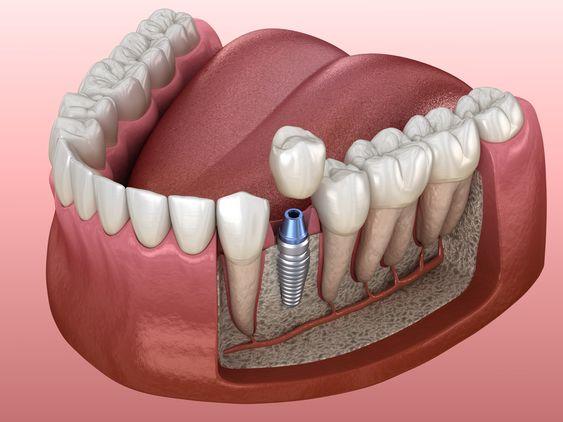Dental Implants: Types, Treatment Procedure, Benefits, Risks

Among these options and highly popular, effective solutions for missing teeth are dental implants. For traditional dentures and bridges, they offer durable and natural options. This article seeks to provide an overview of dental implants concerning their types, treatment procedures, advantages, risks, and costs.
Types of Dental Implants
They also vary in many types depending on the difference in various patients' needs and conditions. A look into various types that exist is given.
1. Endosteal Implants
These are the most frequently put type of dental implant. These are inserted into the jawbone and function as a substitute for the root of a lost tooth. Mostly, such types of implants are made from metals, which are usually titanium; these are cylindrical or tapered in shape. After placement, it takes some time for the merging of the bone with the implant, known as osseointegration. In this stage, a crown is placed on top of the implant to complete the tooth restoration.
2. Subperiosteal Implants
Subperiosteal implants are placed under the gum but on or above the jawbone. This type is generally adopted when patients do not have enough bone height to support endosteal implants. Rather than being inserted into the bone, these implants rest on or near the surface of the bone. Commonly, the implant takes the form of a metal framework carrying the prosthetic teeth.
3. Zygomatic Implants
When there is severe atrophy of the upper jaw, then the resort is made to zygomatic implants. Instead of being inserted into the jawbone, the implant is placed into the zygomatic bone, otherwise called the cheekbone. Because it is longer compared to a regular implant, the surgical procedure when placing a zygomatic implant is more involved. The indications include cases with extreme resorption of the maxilla, where insertion of regular dental implants is impossible, and where augmentation procedures like bone grafting are also not feasible.
4. All-on-4 Implants
The All-on-4 implant technique involves the placement of four implants inside the jawbone to support an entire arch of teeth. This is a very stable, immediate solution in cases of full-arch replacements. Such methods are designed in ways to maximize the available bone in optimal positions, and on many occasions, can have a temporary prosthesis attached the same day.
5. Mini Implants
Mini implants, unlike the others of small diameter, can be used in cases of inadequate bone density or when less-invasive implant placement of denture support is provided. They will offer less invasiveness; however they are applied under special conditions and hence cannot replace all other types of implants.
6. Immediate Load Implants
Immediate load implants provide a chance to place a temporary crown or bridge on the very day of your surgical procedure. The techniques are suitable for patients who may need immediate restoration with sufficient bone density and health. Mostly, the final restoration will be put after the complete integration of the implant into the bone.
Procedural Aspect of Dental Implant Treatment
The dental implant is a multi-stage treatment procedure that requires optimum attention in the planning for its success. A breakdown of how the dental implant treatment procedure will go is given in some steps below.
1. Initial Consultation and Assessment
Purpose: To verify the oral health condition of the patient and assess his/her suitability for implants.
Medical History Review: The dentist assesses the overall health, medical history, and medications.
Oral Examination: This involves the examination of gums, teeth, and jawbone.
Imaging: This is where the dentist assesses morphology and the density of the bone, three-dimensional relationship of the teeth to the jawbone, using X-rays or CT scans, or 3D imaging.
Treatment planning: After that, a treatment plan will then be formulated for each patient, identifying what type of implant, location of placement, and if additional procedures are necessary.
2. Pre-Surgical Preparations
Objective: To prepare the patient's mouth for the implant.
Tooth Extraction: Teeth that are decayed or damaged and that are in the way of the implant are availed for extraction
Bone Grafting: In case there is not enough bone density, then a bone grafting procedure might be performed for lifting the jawbone. Synthetic materials or bone from any other part of the body may be used for this action.
Sinus Lifting: In cases of implant placement in the upper jaw, there may be a need for a sinus lift. This would provide adequate space within the sinus cavity for the implant.
3. Placement of Implant
Objective: The objective is to perform the surgical placement of an implant into the jawbone.
Anesthesia: Anesthesia may be given through local anesthesia. Sedation can also be prescribed depending on the needs of the patient.
Surgical Procedure: Surgery starts with an incision in the gum to expose the jawbone. After exposure of the bone, a hole is drilled into it. In this hole, the titanium implant is inserted. The gum tissue is then stitched back into place.
Healing Time: Through a process that the body uses, called osseointegration, the implant fuses naturally into the jawbone. This may take several months to take place. During this, as the bone heals around the implant, it sets it in its position.
4. Abutment Placement
Purpose: To connect the abutment that the crown will rest upon.
Second Surgery: A second minor surgical procedure is sometimes performed to attach the abutment, or that part of the implant to which the crown attaches. This step is not required if the implant is one piece.
Healing: The gums are allowed to heal around the abutment, which takes a few weeks.
5. Placement of Crown
Objective: Attach the final restoration [crown] to the implant.
Impression: An impression or digital scan is taken of the mouth to create a crown identical to the patient's natural teeth.
Crown Fabrication: With the help of impressions or scans, the construction or building up of the crown is performed in the dental lab. This is constructed in such a way that it will perfectly blend with the surrounding teeth.
Attachment of Crown: After the preparation of the crown, it is then attached to the abutment. The dentist will check on the fit of the crown and makes necessary adjustments.
6. After-care and Maintenance
- Objective: To ensure the implant is going to last a long while in health.
- Oral Hygiene: Proper brushing, flossing, and regular dental check-ups are very important in the health of the implant and the gum around it.
- Follow-up visits: Follow-up visits are also provided where the dentist checks on the integration of the implant and solves any problems.
- Changes in Lifestyle: The patients may be advised to avoid certain foods or life habits that may potentially influence the outcome of the implant positively.
Dental Implant Benefits
Improved Function
The dental implants restore the correct mastication and capacity to speak because, much like the natural teeth, they function in such a manner as to enable one to enjoy foods and, therefore, converse with confidence.
Aesthetic Enhancement
They provide a natural-looking solution that further enhances the beauty of the smile. The crowns are created to match the color and shape of the existing teeth and thus produce a harmonious and pleasing outcome.
Durability and Longevity
With proper care, dental implants can last a lifetime. They are very durable and resistant to decay; hence, they are very long-lasting for missing teeth.
Preservation of Jawbone
Unlike dentures, which may cause the bones to shrink over time, dental implants stimulate the jawbone and help in retaining its density. This will help in preserving the facial structure and prevent the sunken look that usually results when teeth are lost.
Risks and Complications
Infection
Consequently, the risk of infection at the implant site leads to several complications, which include failure of the implant. In view of the foregoing, good oral hygiene as well as post-operative care instructions will minimize aforementioned risks.
Failure of the Implant
Sometimes, the implants do not properly attach to the bone, or they start to loosen after a period. Some of the low bone density, smoking, and poor oral hygiene are the reasons that collectively contribute to making implants a failure.
Nerve Damage
Nerve damage This is a rare complication and usually occurs when the implant is coming too close to any of the nerves. This would affect the region around the implant with numbness, tingling, or even pain. It would most likely be avoided with appropriate planning and imaging.
Problematic Sinuses
Upper jaw implants also risk sinus complications if the implant protrudes into the sinus cavity. Some of these risks can be minimized with a procedure known as a sinus lifting surgery
Cost of Dental Implants
Factors Affecting the Cost
Cost of dental implants can vary depending on several factors including the type of implant, complexity of the procedure, additional treatments that may be needed to support the implant, and the experience of the dental professional. Cost also varies depending on geographic location.
Insurance and Financing Options
Although many dental insurance plans do partially cover dental implants, in fact, the amount of coverage does vary. Patients will need to contact their insurance provider for details about their benefits. Many dental clinics provide financing options and a payment plan to manage the cost of treatment.
Conclusion
Implants represent friendly and handsome substitutes for missing teeth. To let every patient make informed decisions about their dental health, it is of paramount importance to understand the different types of implants, treatment procedures, benefits, risks, and costs associated with the same. If one considers dental implants in Gurugram, then at Dental Krafts, one will have expert care with an individualized treatment plan for the results.










Comments